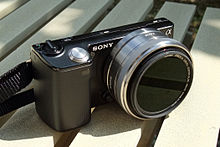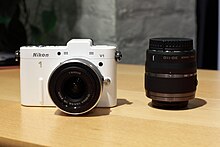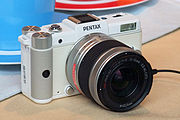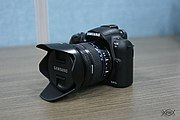MirrorLess Interchangeable Lens Cameras
A mirrorless interchangeable lens camera ( MILC, commonly referred to simply as a "mirrorless camera"), is a camera with an interchangeable lens that does not have a mirror reflex optical viewfinder.
 Mirrorless cameras are available with a variety of sensor sizes
including 1/2.3", 1/1.7", 1", Micro 4/3, APS-C, and full frame. When
sales of DSLRs fell in 2013, many camera manufacturers, including Nikon,
responded by releasing many Mirrorless cameras including the lenses.
Mirrorless cameras are available with a variety of sensor sizes
including 1/2.3", 1/1.7", 1", Micro 4/3, APS-C, and full frame. When
sales of DSLRs fell in 2013, many camera manufacturers, including Nikon,
responded by releasing many Mirrorless cameras including the lenses.
As of 2014, several mirrorless camera systems were available. In
chronological order (by their introduction) and referring to the adopted
lens-mount type, they are: Epson R-D1 using Leica M mount in 2004; Leica itself in 2006; Micro Four Thirds mount for Olympus and Panasonic; Samsung NX-mount; Sony E-mount; Nikon 1-mount; Pentax Q mount for Pentax small-sensor Mirrorless (Pentax Q); K-mount for both Pentax DSLRs and Pentax large-sensor mirrorless; Fujifilm X-mount; and Canon EF-M mount
. (Sony's full-frame Mirrorless, introduced in late 2013, use the same E-mount as the company's APS-C Mirrorless, but attain full-frame coverage with "FE" lenses.)
Mirrorless types
Three styles of mirrorless exist: Compact, "Rangefinder" style which can have slim electronic in built viewfinders, and DSLR style which while thinner than DSLRs their electronic viewfinders are located in humps that resemble the DSLR form factor. Compact-style cameras are approximately the size of larger compact cameras, "Rangefinder" varies a lot in size depending on sensor size while DSLR-style mirrorless cameras overlap with entry-level DSLRs in styling with significantly thinner and lighter bodies. "IBIS" sensor stability systems which stabilise lens via a sensor that floats in a magnetic field have also have increased the depth or thickness and weight of mirrorless cameras. No DSLR has IBIS stability technology.
 |
| Sony NEX-5 |
In 2013, Sony announced a transition away from the NEX brand name, with future cameras in that family to be called Alpha ILCE; six mirrorless in the renamed family, the Alpha 7, 7R, 7S, 7-II, 7R-II and 7S-II are full-frame.
Sensor size
There is an inevitable trade-off between sensor size and compactness of the camera, due to the size of the lens required. Sensor size varies among mirrorless interchangeable-lens cameras. The Micro Four Thirds system uses the same size sensor as the 225mm2 Four Thirds System (smallest among DSLRs but nine times the area of typical compact camera 25mm2 1/2.5" sensors), while the Fujifilm X cameras, Samsung NX cameras and Sony NEX cameras use a 65% larger APS-C size sensor of 370mm2. The Canon EOS M uses a slightly smaller APS-C sensor with an area of 329mm
 |
| Nikon 1 V1 with Nikkor 10-30mm f/3.5-5.6 attached, and the Nikon 1 mount 30-110mm f/3.8-5.6 telezoom lens |
As of October 2015, the available full-frame 24×36 mm (864mm2) mirrorless cameras were five closely related Leica models (M9, M9-P, M-E, M Monochrom, and M, with the Monochrom shooting solely in black-and-white) and six Sony models from the NEX/mirrorless family (Alpha 7, 7R, 7S, 7-II, 7R-II and 7S-II). With the Leicas all being rangefinder cameras, they have optical viewfinders and thus can be called Mirrorless. The Sony models, on the other hand, come equipped with electronic viewfinders. According to DxO Labs, all three newer Sony cameras have better sensor quality than the Leica rangefinders; the Leica M type 240 has only scored 84 for Sensor Overall, compared to 87, 90, 95 and 90 for the Sony A7S, A7, A7R and A7-II, and the A7R-II was described by DxO has being "The new high water mark in sensor dynamics" with a score of 98, respectively
Drawbacks
Mirrorless share many of the limitations of compact cameras. These include:No TTL optical viewfinder
The Olympus PEN E-PL5 features a tiltable LCD
Lower cost mirrorless primarily use a rear LCD display for arm-level shooting, but some also feature an electronic viewfinder (EVF) for eye-level shooting. EVFs once suffered from a noticeable lag between the changes in the scene and the electronic viewfinder display, newer EVFs have improved their resolution and response times, with lag no longer being apparent. As a lower-priced option, some systems offer an optical viewfinder that is not TTL (as in a rangefinder), which suffers from parallax, particularly at short distances. EVFs allow overlay of complex real-time information such as focus peaking, under/overexposure "blinkies", AF regions, face tracking, digital zoom, image intensity adjustments with different light levels and histograms. Much higher resolution EVFs are now mature, and many mirrorless cameras now feature not only high resolution OLED viewfinders with no lag, but some offer more magnification than any DSLR provide. EVFs allow manual focusing technologies superior to optical viewfinders, such as the combination of digital zooming and focus peaking.
Compatibility with lenses from older systems
Panasonic M4/3 Camera are compatible with Olympus M4/3 Lens
As the largest investment in a system camera is the lenses, not the body, and lenses often last decades, changing a mount and rebuilding a lens collection is a significant investment. The use of a Mirrorless system with adapters allows a DSLR user to adopt a new system without losing their prior investment in lenses. A particular advantage with Olympus's and now Sony's A7-II IBIS system, is that adding a lens without OIS will result in the lens gaining a stability system in the Olympus range. Also, older but good quality lens from discontinued systems that were considered useless have now increased in value by many times due to Mirrorless owners using them on their cameras.
Recently manufacturer's of adapters have allowed electronic (2006 and onwards) Canon DSLR lenses to focus on Sony's A7R-II and A7-II cameras, both of which have phase focus points in their sensors. Some lens focus quickly, but not all, and in January 2016, longer focus lengths such as beyond 200mm focus inconsistently, and some lenses focus better than others. Some adapter manufacturers have introduced adapters that will focus electronic Nikon and Canon DSLR lenses and handle light issues on recent Panasonic m43 cameras, and it is possible more mirrorless manufacturers will assist in their mirrorless cameras being able to adapt DSLR lenses to their cameras. Issues due to different sensor sizes will effect the focal length of such adaptions, and also the depth of field will change if sensor sizes do not match the DSLR original sensor size.
Higher end mirrorless cameras feature focus peaking, which aids manual focusing used with third party lenses especially and focusing when videoing.
Adapters exist for legacy lenses although most do not support autofocus on mirrorless bodies. Micro Four Thirds has adapters for Arri PL, Arri S, C-mount, Canon EOS, Canon FD, Contax G, Contax/Yashica, Four Thirds, Konica AR (Hexanon), Leica M, Leica R, M38, M42, Minolta MC, Minolta MD, Minolta SR, Nikon F, Nikon G, Olympus OM, Olympus Pen F, Pentacon 6 / Kiev 66, Pentax K, Practica B, Rollei 35, Sony Alpha, T2, and Tamron Adaptall II mounts. The Sony E-mount has an adapter for the older Minolta A mount, Four Thirds, Canon FD, Leica M, M42, Nikon, Olympus OM, Minolta, Pentax K, and C mounts. The Nikon 1 series has an adapter for the company's F-mount, and the Canon EOS M has an adapter for that company's EF-S mount, which also accepts EF lenses. However, part of the benefit of MILCs is that newer, smaller lenses can be used; to realize these benefits, either new lenses or lenses for short flange distance legacy mounts, such as those used on rangefinder cameras, are required.
A Sony NEX 6 (camera on the left) using a DSLR lens via an adaptor
This drawback, however, is somewhat balanced by the fact that some Mirrorless cameras are small and light enough to be aimed at the "point-and-shoot" market where users are satisfied with the kit lens or an all-around "super-zoom", while other cameras in the same system are fully featured and designed for professional use encouraging the user to build a large system around their cameras.
For manufacturers, this strategy eliminates price competition for their new lenses from second-hand legacy lenses.
Market
Compact-style Mirrorless with pancake lenses generated significant excitement in the photographer community, as they finally provided a pocketable digital camera with a large sensor (hence high image quality). DSLR-style Mirrorless, and compact-style Mirrorless with larger lenses have also generated interest, and with Full Frame Mirrorless with internal IBIS providing lighter and more compact still and video capabilities Mirrorless is offering new possibilities to the DSLR concept.Beyond the interest to consumers, Mirrorless has created significant interest in camera manufacturers, having potential to be an alternative in the high-end camera market. Significantly, Mirrorless has fewer moving parts than DSLRs, and are more electronic, which plays to the strengths of electronic manufacturers (such as Panasonic, Samsung and Sony), while undermining the advantage that existing camera makers have in precision mechanical engineering. Sony's entry level full frame mirrorless A7MkII camera has a 24MP 5 axis stabilised sensor yet is more compact and lower in cost than any full frame sensor DSLR.
Nikon announced the Nikon 1 series on September 21, 2011 with 1" sensor. It is a high-speed Mirrorless which according to Nikon featured world's fastest autofocus and world's fastest continuous shooting speed (60 fps) among all cameras with interchangeable lenses including DSLRs.Canon was the last of the major makers of DSLRs, announcing the Canon EOS M in 2012 with APS-C sensor and 18mm registration distance similar to the one used by NEX.
In a longer-term Olympus decided that Mirrorless may replace DSLRs entirely in some categories with Olympus America's DSLR product manager speculating that by 2012, Olympus DSLRs (the Olympus E system) may be mirrorless, though still using the Four Thirds System (not Micro Four Thirds).
Panasonic UK's Lumix G product manager John Mitchell while speaking to the Press at the 2011 "Focus on Imaging" show in Birmingham, reported that Panasonic "G" camera market share was almost doubling each year, and that UK Panasonic "G" captured over 11% of all interchangeable camera sales in the UK in 2010, and that UK "CSC" sales made up 23% of the Interchaneable lens market in the UK, and 40% in Japan.
As of May 2010, interchangeable-lens camera pricing is comparable to and somewhat higher than entry-level DSLRs, at US$550 to $800, and significantly higher than high-end compact cameras. As of May 2011, interchangeable-lens camera pricing for entry Mirrorless appears to be lower than entry-level DSLRs in some markets e.g. the USA.
In down-trend world camera market, Mirrorless also suffer, but not much and can be compensated with increase by about 12 percent of 2013 sales in popular Mirrorless domestic (Japan) market.However, Mirrorless has taken longer catch on in Europe and North America—according to Japanese photo industry sources, Mirrorless made up only 11.2% of interchangeable-lens cameras shipped to Europe in the first nine months of 2013, and 10.5% in the US in the same period.[41] Also, an industry researcher determined that Mirrorless sales in the US fell by about 20% in the three weeks leading up to December 14, 2013—which included the key Black Friday shopping week; in the same period, DSLR sales went up 1%.
2015 statistics show that overall camera sales have fallen to one third of those of 2010, due to compact cameras being substituted by camera capable mobile phones. This means that overall share of camera sales is seeing ILC market share increasing, with world volumes showing ILC having 30% ofr overall camera sales, of which DSLR had 77% and Mirrorless 23%.In the Americas in 2015, DSLR annual $ sales are now falling by 16% aper annum, while Mirrorless sales over the same 12-month period have increased by 17%. Hence the Mirrorless market share of interchangeable lens cameras has more than doubled in two years.
 |
| Belanove K Binu |
About The Author
Belanove is a Software Engineering Student and a photographer who has spent the last 5 years Researching and Understanding Dslrs & Technology
but has never hacked DSLR and specializes in writing about Photography Products and Emerging photography technology.
When not writing for DSLR360, Belanove Conducts photography classes online,Goes out for bird watching,Wildlife photography and off course Attends college.








No comments:
Post a Comment